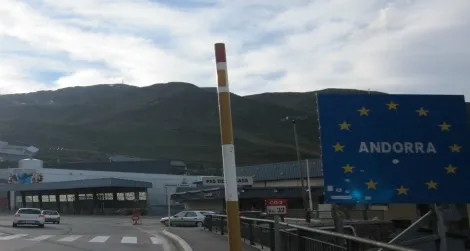On the highest paved pass in the Pyrenees, Andorra has planted a McDonald’s sign—an indication of the country’s lenience toward commerce. Photo by Alastair Bland.
The French had warned me that Andorra wasn’t pretty, but I didn’t believe them. How, I wondered, could a mountainous country, located smack between two of the most handsome countries in the world, be dead ugly? But Andorra is, and I would guess that Andorrans, should they read this, will bristle with a sort of pride—because clearly they haven’t sought to make their country pretty to the eye, though they had every chance. They had green mountains, with chamois and trout streams and wildflowers; they had cliffs and meadows and waterfalls; shoot, they even had the prettiest name in Europe, and they squandered it all. For one thing, Andorra has abandoned almost all endeavors agrarian (just 9,000 sheep live here; 100,000 live in the French Pyrenees). And so they grow a little tobacco, import nearly all their food and dedicate themselves to the shopping and services industries. With every slab of concrete they lay and every faux cobblestone they set and every neon light they plug in, they appear to have the goal of marring their landscape. They’ve succeeded grandly.
In France, a traveler may say to himself 30 times a day the following four words: “What a charming village.” In Andorra, such words are not spoken, at least not in that order. Instead, people say, “Cheap cigarettes!” and “Ten pairs of tube socks for 3 Euros!” and “Hooray, they’ve just opened a new perfume outlet in Canillo!”
Mountains, blue sky and sunshine cannot bring redemption to the artificial scenery of Andorra. Here, in the capital city of Andorra la Vella, the chief river of the valley flows over a bed of concrete. Photo by Alastair Bland.
One might say that Andorrans have done the best with what they have—a river canyon cut into a steep and largely rocky mountainside. I’ve seen official documents that call Andorra’s terrain—98 percent of it, to be exact—unsuitable for agriculture, but let’s keep things in context: That land is also unsuitable for perfume outlets and duty free liquor and jewelry shops. And so the Andorrans have crammed all that they hold dear into the available land that flanks their one major highway, which careens at a 10-percent gradient in places from the high pass all the way to Spain. Along the road’s shoulder are chain-link fences and concrete barriers. There are several picnic pullouts which have been carpeted with plastic turf. Billboards and name brands scream at travelers from every direction—McDonald’s, Pepsi and all the rest. But besides commerce, there are resident people here. About 90,000 people enjoy the privilege of calling themselves Andorran. They live in scab-ugly apartment buildings, smog-gray and five stories tall and which permanently block the sunlight from the streets below—which are remarkably noisy for such a small country. Here, Andorrans walk about briskly, attractive and slim as Italians, people who dress sharply, carry glitzy shopping bags and always, it seems, have somewhere to go. There is virtually no unemployment in Andorra. It’s a country both blessed and blistered by prosperity—and they can have it. I had a glance, I had the glory of climbing 6,000 vertical feet to see it, and now I’ve had all I wanted. I am sitting in an Andorran coffee shop now, looking at my map of Spain.
For those of you who don’t care to ever visit Andorra, who could blame you—but here are a few facts and figures on this funny little landlocked nation:
Size: 180 square miles (about four times the size of San Francisco).
Population: 84,300 in 2010.
Capital city: Andorra La Vella, population 22,000—and the highest capital city in Europe, at 3,356 feet.
Main agricultural crop: Tobacco.
Highest point: Coma Pedrosa, 9,665 feet.
Average altitude: 6,000-plus feet.
Wildlife: Includes trout, bears, eagles, chamois, foxes and ducks.
Armed forces: None. (Andorra’s only expense on weaponry is reportedly for ammunition used in ceremonial salutes.)
Main industry: Tourism.
Main tourist draw: Shopping.
Tourists per year: About 10 million.
Restaurants: 400.
Employment: One percent in agriculture, 21 percent in industry, 78 percent in services.
Sheep population: 9,000 (compare to 30 million in New Zealand).
Cow population: 1,100.
Horse population: 200.
From France, one sees Pas de la Casa ahead. Rather than turn and run, French shoppers flock to Andorra for the prospect of saving a few Euros on cigarettes, liquor, shampoo and glitzy clothing. Photo by Alastair Bland.
Planning Your Next Trip?
Explore great travel deals
Smithsonian magazine participates in affiliate link advertising programs. If you purchase an item through these links, we receive a commission.
Filed Under:
Nature,
Rituals and Traditions,
Travel
Source link : https://www.smithsonianmag.com/travel/andorra-the-ugliest-country-in-europe-121002597/
Author :
Publish date : 2012-06-14 07:00:00
Copyright for syndicated content belongs to the linked Source.
